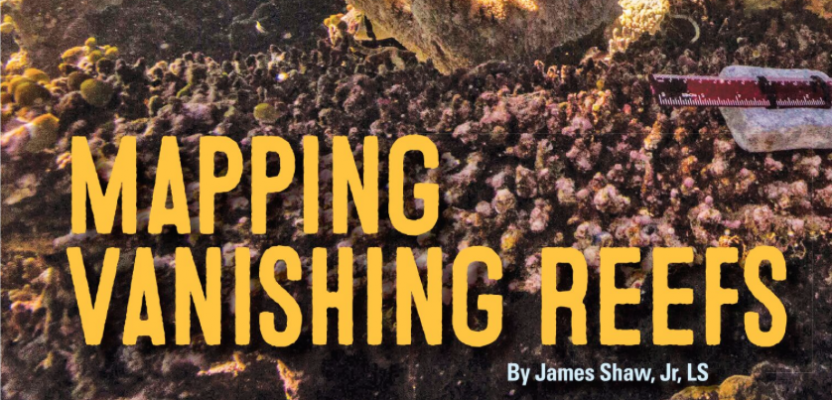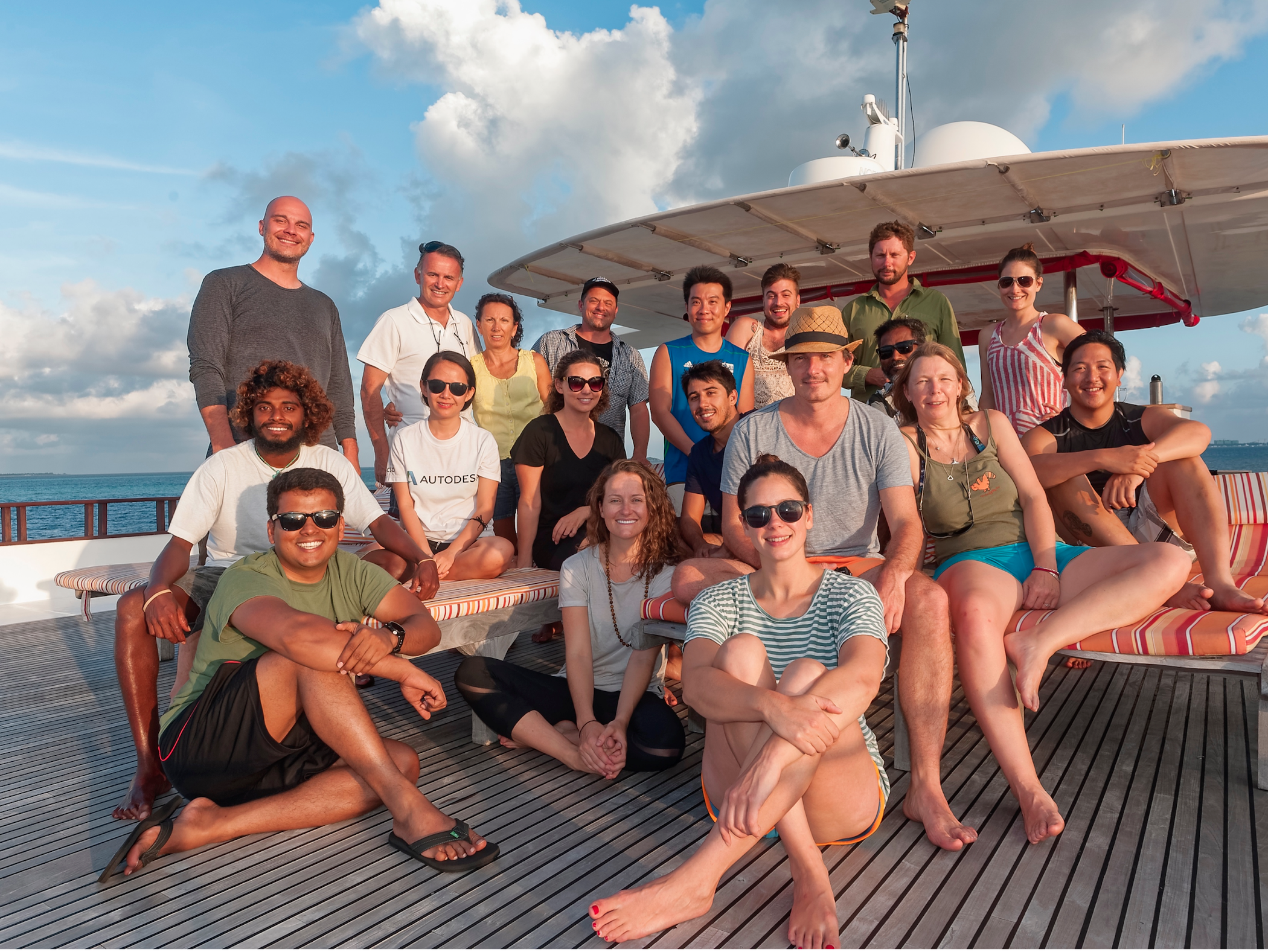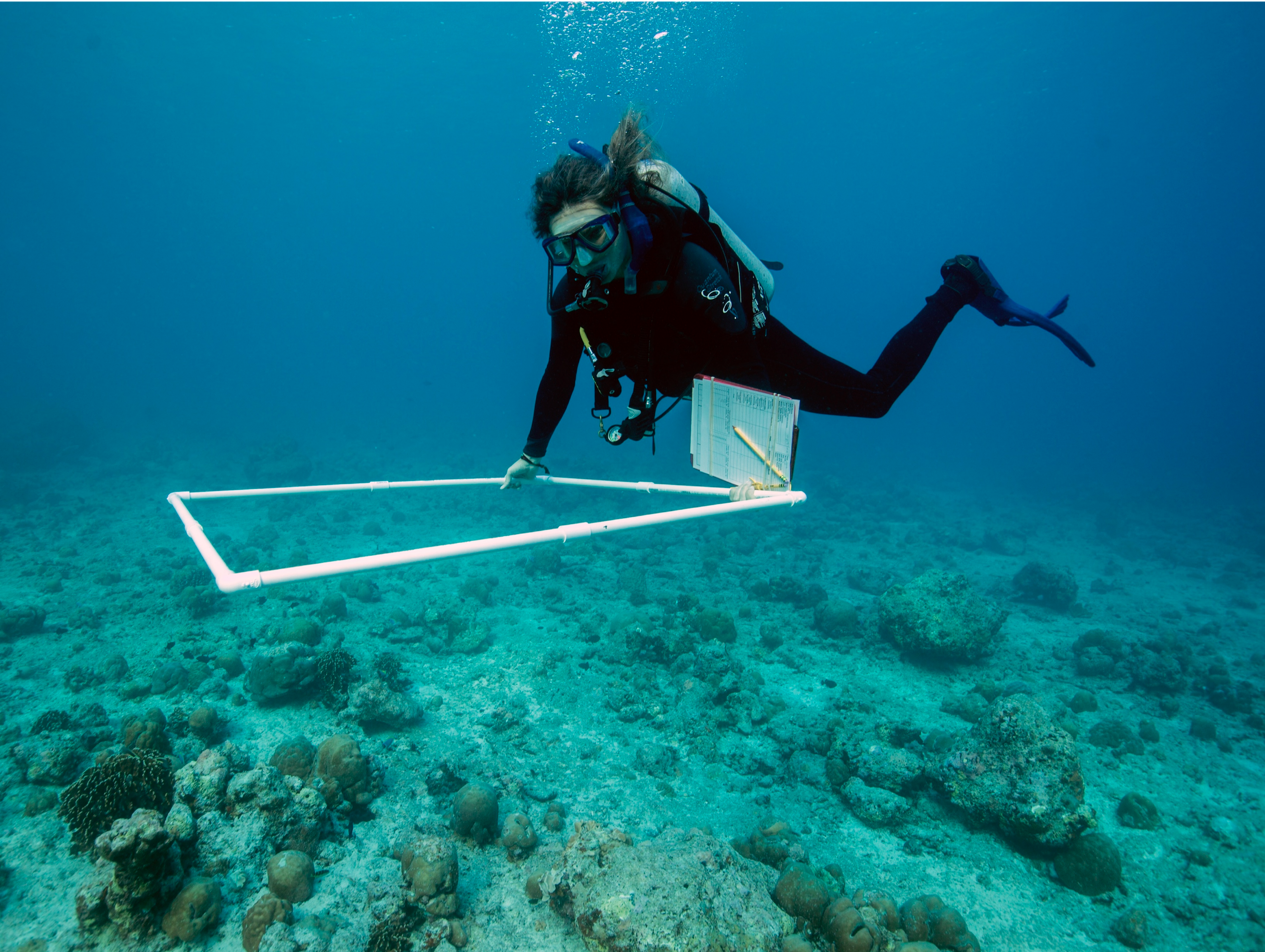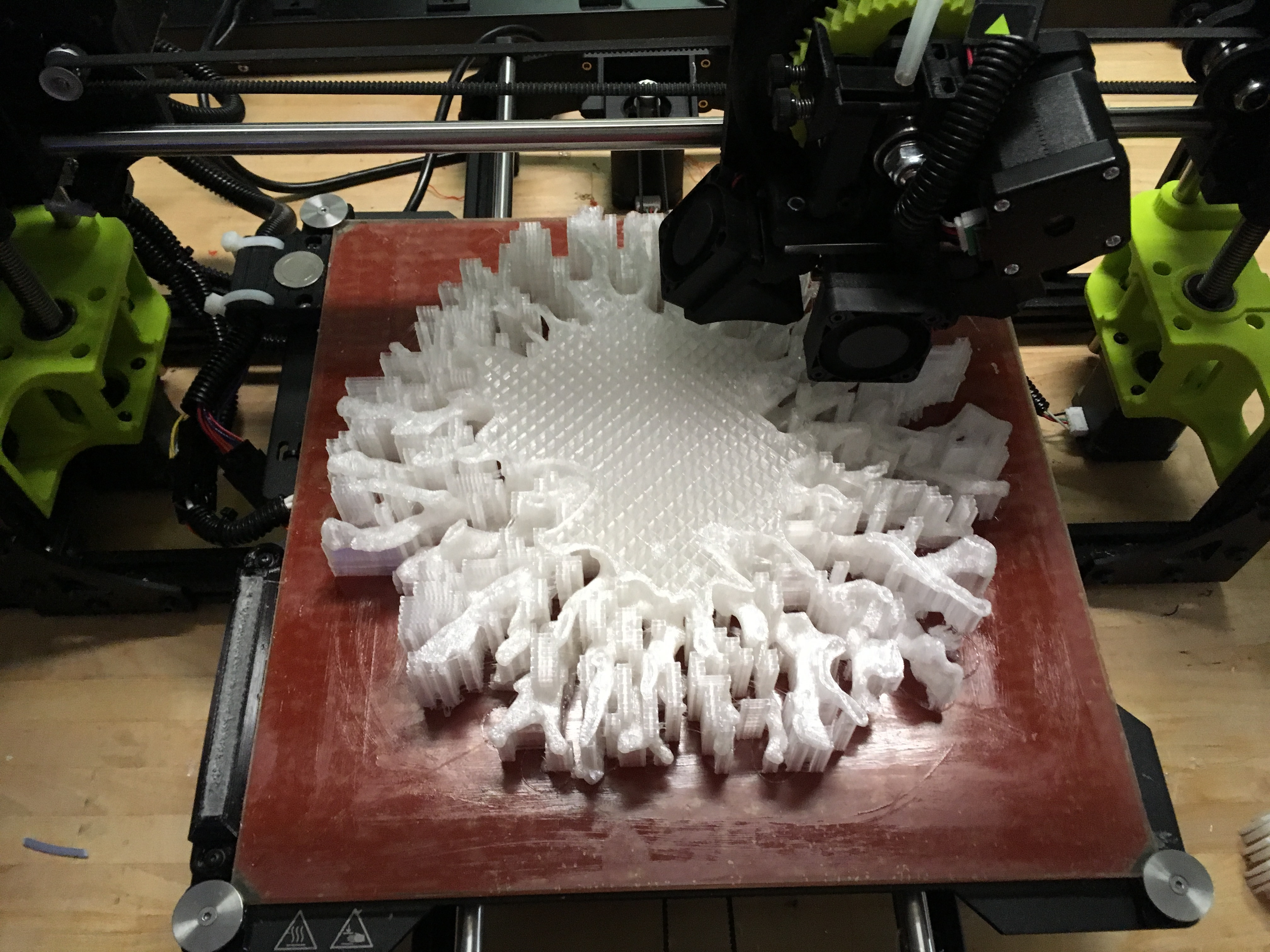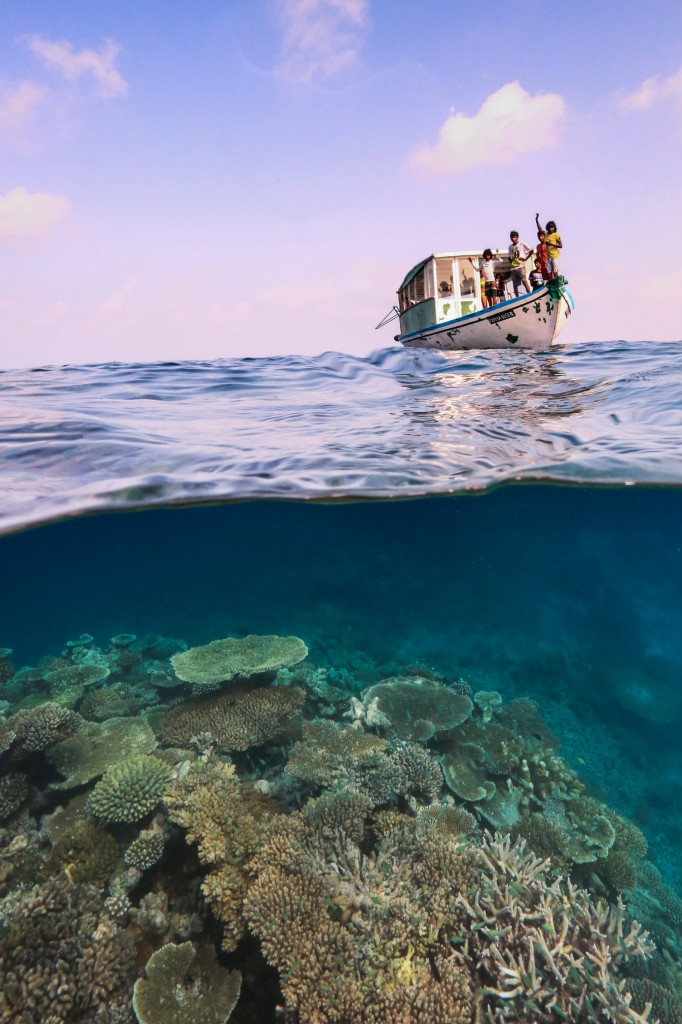Using geospatial technologies, The Hydrous provides “open access” to oceans in an attempt to save critical habitats.
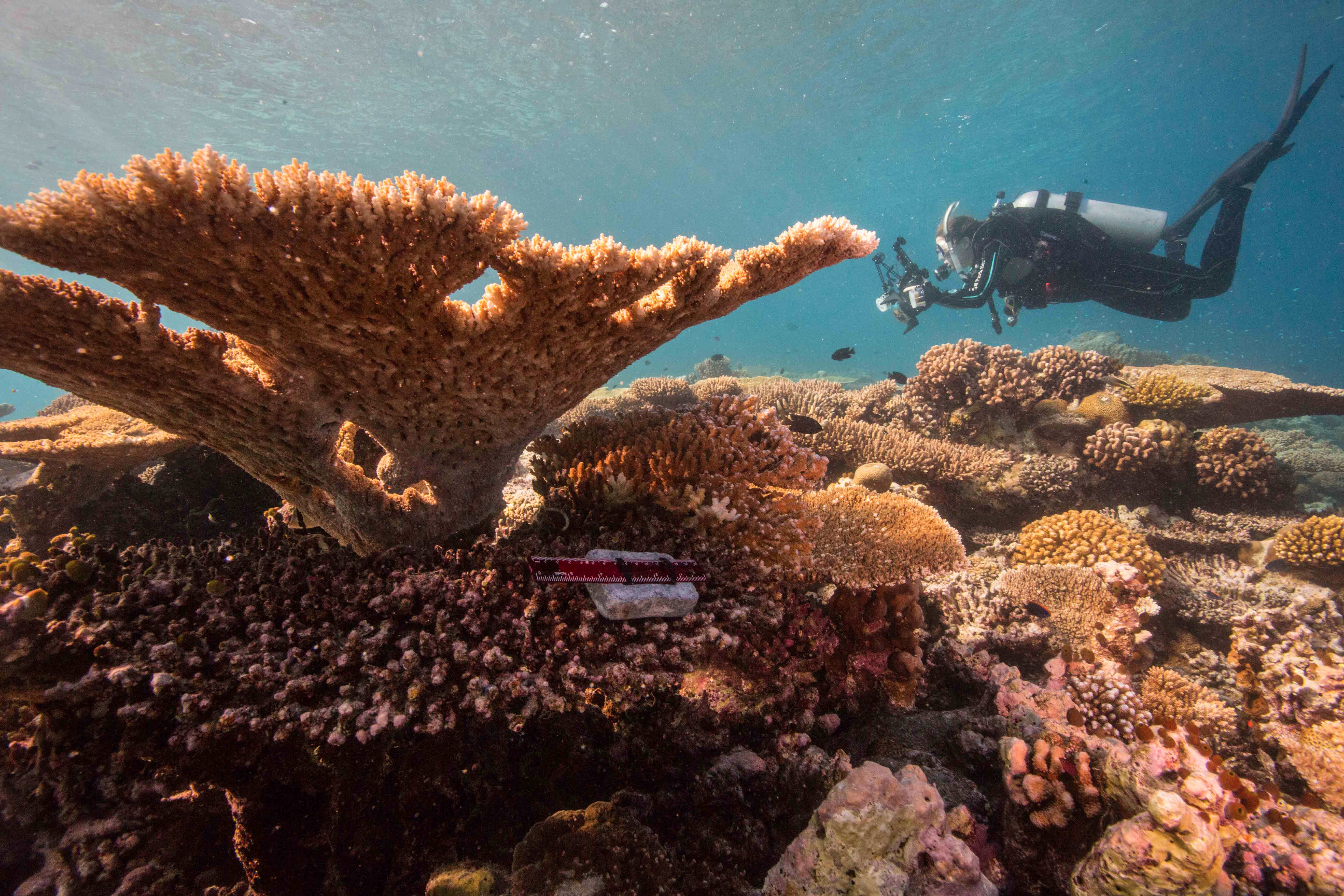
A Hydrous photogrammetrist uses a DSLR with underwater housing and strobes to collect data for a 3D model, with a physical ruler in the photos (center) to ensure accurate scaling.
The oceans of the world are vital to our survival. While monitoring their health is the realm of scientists and protecting their health is the responsibility of everyone, few of us truly experience the richness of these aquatic habitats. This is where Dr. Erika Woolsey, co-founder and CEO of the non-profit organization The Hydrous, is making a difference.
“Open access oceans” is the mission statement of The Hydrous. The goal is to make the ocean experience portable using virtual reality (VR), 3D modeling, and 3D printing. Bringing the oceans to people minimizes human impact while maximizing sympathy, understanding, and collective stewardship. Geospatial technologies are enabling this mission.
xyHt readers might recognize Woolsey; she was featured in the January 2017, “40 Under 40” issue. Meeting Woolsey in person, though, is quite different. You may first notice her blue eyes and broad smile. A few moments in, there is something else. Passion.
Woolsey is passionate about her mission. It is evident in her words, intelligently and thoughtfully chosen to engage. There is also an intensity and confidence in her unwavering gaze that conveys an unshakeable drive. Woolsey wants to save the world by connecting to each and every one of us.
“Our message is universal. It’s all one ocean. It’s all connected,” she states.
The Importance of Coral Reefs
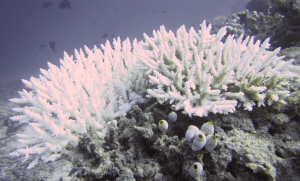
Bleaching is when the coral animal gets stressed from environmental factors and expels its endosymbiotic algae, which the coral needs to survive. This process turns the coral animal clear, making its white skeletons visible. A bleached reef is not yet a dead reef, but it is dying.
If The Hydrous is working for total oceanic conservation, then why focus on corals? Woolsey’s background and specific area of study happens to be coral reefs, but they’re also critically important.
“Coral reefs feed hundreds of millions of people. They protect shorelines from erosion. They act as natural breakwaters. They harbor about a quarter of all marine biodiversity. They’re like the rainforest of the ocean,” Woolsey elaborated.
80% of all lifeforms live within the oceans, and coral reefs house a significant portion of those lifeforms.
Despite these benefits, about 50% of reefs have been lost in the last 50 years, and that pace is accelerating.
“The Great Barrier reef has bleached two years in a row—which is unprecedented. Bleaching happens on coral reefs, but they usually can recover. It wasn’t an issue before the 1980s. El Niño events didn’t cause these mass deaths. It’s just now, that temperatures are creeping up, that it is really hard for these environments to bounce back.”
Bleaching is a process by which the endosymbiotic algae that live within the coral, and gives the coral 90% of its energy, becomes stressed due to environmental factors, thus beginning an expulsion from the coral. These events happen rapidly and dramatically, leaving the coral white or without color–hence the term “bleaching.” Bleaching itself does not kill the coral, but if they cannot restore the symbiotic relationship with the algae the corals eventually die due to starvation. In 2016 about 80% of the Great Barrier Reef experienced bleaching due to higher than normal water temperatures.
Temperature is not the only factor affecting the reefs; coral lives in substrates based on depth. While corals can adapt to sea level changes, their adaptation is very slow. After the last Ice Age, when the polar ice melted, the sea level change happened so quickly that those corals died off due to starvation when the algae was no longer getting the same amount of light as it previously had. Our current climate change threatens a similar die off due to sea level rise from polar ice melt with the added strains of rising temperatures and severe storm damage.
In the past cyclones helped with diversity in The Great Barrier Reef, similar to a forest fire creating healthier forests. In recent years, as the climate warms, these cyclones have become bigger, stronger, and more frequent. While coral can recover from the impacts of cyclones, the recovery period is longer than the current frequency of the storms.
“Corals are tough. They have been around for 250 million years and their ranges have expanded and contracted with the shifts in temperature and sea levels. They have survived six mass extinctions,” Woolsey explained.
“But, the current pace of change is unprecedented. It’s not as though they are on a planet by themselves. They have all these other stressors.
“If there is a reef that has been bleached, and it is also being overfished: that is breaking down the resilience of the ecosystem. And if the reef is also being polluted, and it has all this agricultural runoff, and being ravaged by massive storms, the corals don’t stand a chance. It’s a death by a thousand cuts.”
Given all the clear benefits of the coral reef ecosystem, why does this not draw more worldwide support?
“A big part of it is science’s fault. We are putting all of our information in silos and hard-to-access, expensive journals in a language that is not understandable to most people.”
Woolsey continued, “Something I realized as I progressed in my science career was that my audience was getting smaller as I specialized. It was other scientists that were interested in my particular field of research, but, it is a time in the world that this audience needs to get bigger and bigger.”
This is the spark that led to The Hydrous.
The Hydrous Approach
The Hydrous has a fresh approach to building engagement.
“Datasets do not spark emotional investment. When it comes to conservation, you need that human connection,” Woolsey elaborated. For the lucky few, this means a spot on one of The Hydrous’ many expeditions. These highly coveted positions typically include an international team of scientists, diving enthusiasts, investors, local partners, and filmmakers. Traveling to reef systems around the world has brought the expeditions to the Hawaiian Islands, Easter Island, Palau, Guam, Indonesia, Solomon Islands, Belize, the Maldives, and Woolsey’s favorite, The Great Barrier Reef of Australia.
Scientific data collection is the primary purpose of these revenue-generating expeditions. This is accomplished using many tools already familiar to the geospatial community, including GPS/GNSS, close-range photogrammetry, and aerial drones.
Additionally, these expeditions bring the team members in direct contact with reef communities to experience different cultures and to learn how vital the reefs are to the survival of these people. For the non-scientists on the expedition, the dives are an educational opportunity as the divers learn to identify various types of coral and assist in the 3D modeling and virtual reality collection.
Datasets do not spark emotional investment. When it comes to conservation, you need that human connection.
The expeditions are only a small step in raising global awareness. It is through sharing the results that The Hydrous really reaches out to the masses.
The Hydrous employs technologies that allow anyone, no matter how remote they are to an ocean, to be submerged into the marine ecosystem. The goal is to provide 3D models, both virtual and physical, and to create short VR films that can be delivered online to anyone with a desktop computer, smartphone, or VR headset.
Woolsey explains, “There is really interesting research into the possibilities of these new technologies for generating a connection that results in action. Of course, that adds the challenge of monitoring impact. It can be quite difficult to prove that you taught somebody something.”
Teaching is vital. Classroom-oriented science curriculum is developed around these VR films. Google Expeditions and Hiverlab assists in delivering the VR experiences to teachers to provide their students virtual field trips to the reefs. All the curriculum aligns with the Next Generation Science Standards, a set of in-depth standards aimed at teaching key science skills: communication, collaboration, inquiry, problem solving, and flexibility.
The Hydrous is also working on bringing Liquid Jungle, an interactive coral reef experience, to museums and public aquariums. This immersive display is designed to deliver a sensory adventure using The Hydrous VR content on surrounding screens and motion sensors to simulate diving on the reefs.
“One of the issues with VR is it can be potentially quite isolating. With motion and touch technologies, we can move outside of a headset and create a space–a room–that interacts with an individual or even a group.”
Enhancing the Liquid Jungle environment are physical 3D coral models. These models allow the virtual divers to touch and feel coral in a non-invasive manner, creating a more encompassing sensory experience.
Documenting the Reef
Of course, presenting the reef environment as VR and 3D models requires documenting the reef. This is a large portion of each expedition’s focus.
Traditionally, reef measurements were made with two-dimensional tools such as tape measures and rugosity chains. These tools were used to attempt to answer three-dimensional questions such as growth and the basic reef structure, but these methods were antiquated, terribly inaccurate, and risked minor damage to the reef.
Most importantly, these tools could not answer the most fundamental question of reef health–the surface area–because the living portion of the reef is only a thin veneer on the uppermost reaches of the coral structure.
“When The Hydrous began, we were known for reality capture of coral reefs. Photogrammetry and the digital models created from photogrammetry are really useful because we can get measurements on volume and surface area, which are ecologically valuable and allow the comparison of growth among time points.”
Using photogrammetry to document underwater features was a technique familiar to Sly Lee, another co-founder of The Hydrous. Lee helped pioneer the use of underwater photography to create 3D models of coral structures. DSLRs and GoPro cameras are now the chief tools of aquatic measurement.
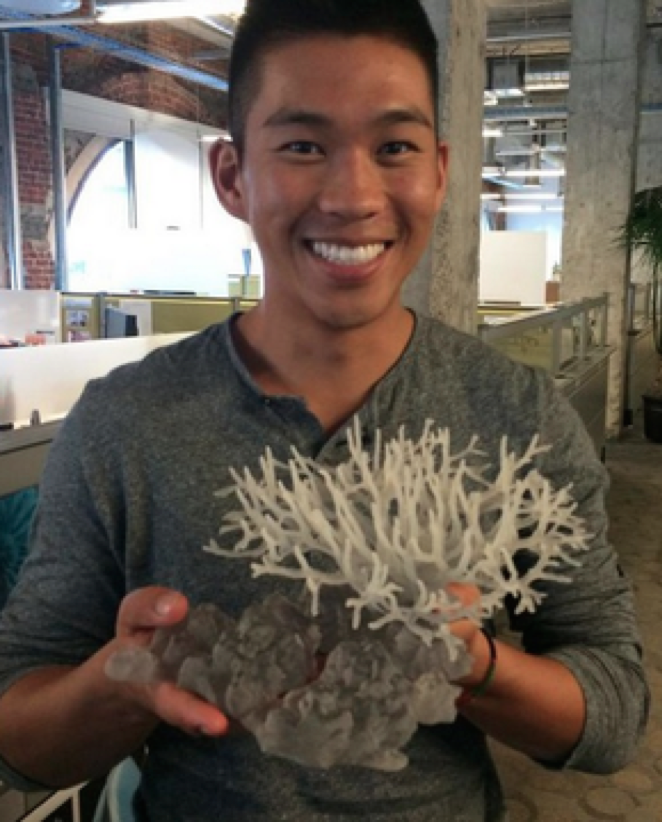
Hydrous co-founder Sly Lee holds a 3D printed coral, a reproduction of a real, living coral colony that is hopefully still thriving on the reef.
This technique is an essential part of The Hydrous’ mission and an important non-invasive, non-destructive, in situ tool for accurate 3D measurements being adopted by many marine biologists. To document a site 10 meters by 10 meters involves taking several thousand photographs over several dives, taking approximately three hours to collect in total.
The goal, as with any close-range photogrammetry, is to provide at least 70% overlap and multiple viewing angles throughout the target area to mitigate voids in the data and to accurately document vertical structures. To ensure accurate scaling of the resulting model, a physical scale is placed within some of the photos.
Autodesk has been a key partner in the process, sponsoring expeditions and providing hardware and software support and technical know-how. With Autodesk Remake, the photogrammetry is converted into high-accuracy 3D models that can be used for visualization, scientific analysis, and 3D printing.
Determining the precise geodetic location of a reef is another challenging task. GPS/GNSS does not work underwater. Often, GNSS positioning will be recorded at the surface just prior to entering the water. Because reefs are generally found near shorelines, ground measurements and directional readings can also assist in locating reef coordinates.
Physically tagging the corals can assist the diver in returning to a known structure. On rare occasions, underwater markers may be submerged and used as a reference system. Typically, the unique form of each reef makes a location identifiable due to general visual familiarity.
Combining geospatial technologies can assist in the large-scale identification of reef locations. In shallow waters, aerial drones are used to stitch together georeferenced imagery into a photo-mosaic. As the water deepens, georeferenced multi-beam sonar data, when available, will be added to create a more complete picture. The sonar is infrequently used because of the expense of deployment.
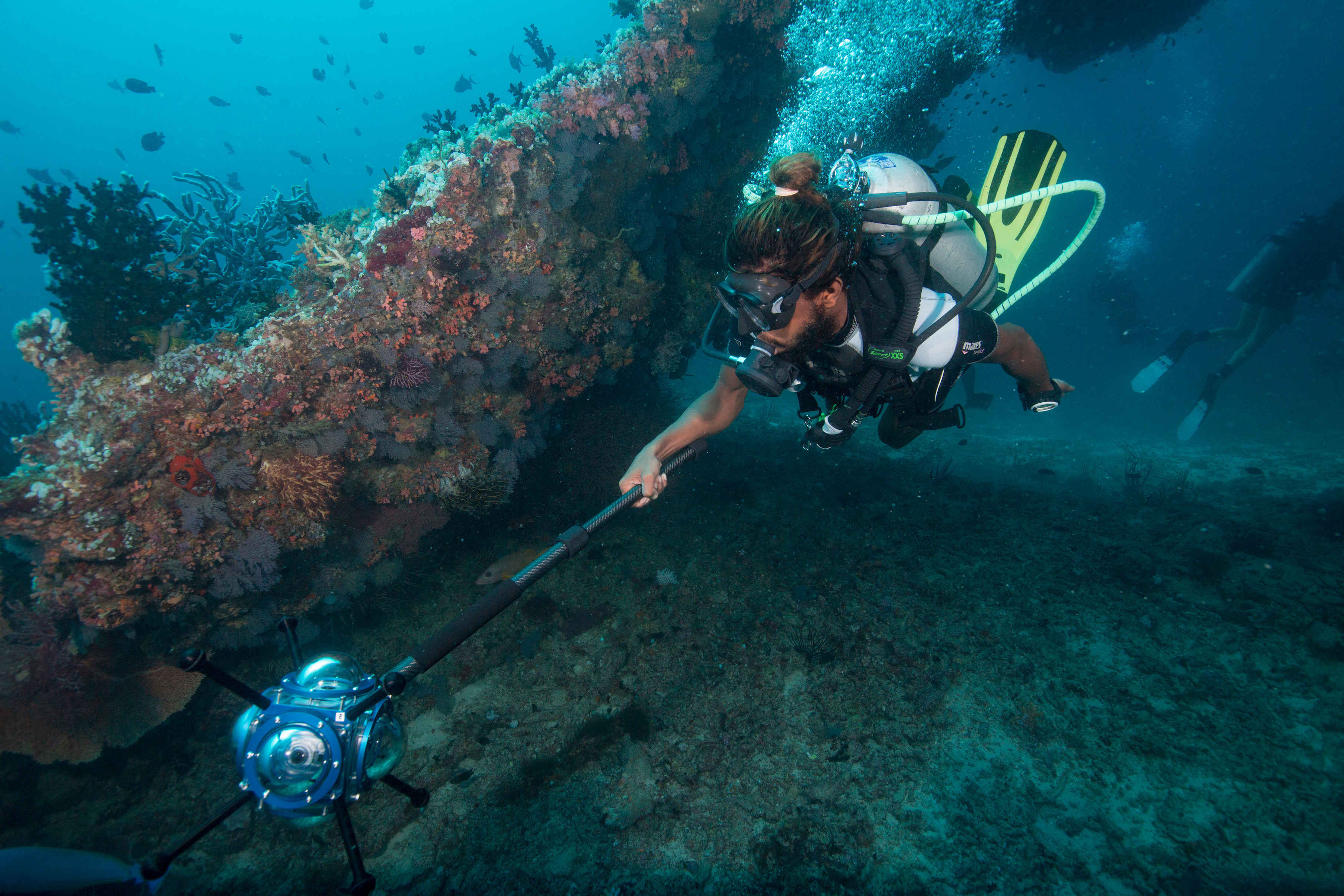
Hydrous team member Mohamed Abdulla (“Patchi”) films a coral reef in the Maldives to create an immersive VR experience.
Coral Modeling
For Woolsey, 3D printing of the models is a critical part of creating engagement.
“We take the models into art galleries, public lectures, and classrooms. People can touch them. It is important to have something that is tangible. We have found that they really spark conversation about coral biology, marine biology, and ocean science.
“These models are helping scientists study coral morphology and ecological function without removing the corals from their habitat, thus preventing their destruction. In situ analysis also allows the comparison of models over time to monitor growth rates.”
Innovative conservation can lead to unique and often unexpected partnerships, such as The Hydrous’ collaboration with Ronald Rael, associate professor of architecture for the University of California Berkeley. Rael specializes in creating large-scale 3D structures from a variety of unique materials, such as calcium carbonate (CaCO3), the underlying skeletal structure of corals.
Using the native composition of coral species to produce 3D printed substrates preferred by coral larvae could lead to manufacturing better man-made reefs. This technique is currently being tested in research laboratories.
Printing, alone, is not sufficient for success. Coral larvae are attracted to the general smell of the reef, and that includes the smell of algae like crustose coralline algae. Introducing these algae to the 3D printed corals should help create an enticing habitat. Coral are adaptive organisms, but their time-scale for adaptation is much longer than the current pace of change brought about by human and climate stressors. It may be possible with the 3D printing techniques to place prime coral habitats in the optimum locations, shifting the habitable zones more quickly than the coral could through their own natural processes.
Climate Change
Despite the obvious need for support, conservation is not an easy task.
“It is disappointing that those in decision-making positions choose to ignore overwhelming evidence. I’m very concerned. It comes down to what we’re trying to do, to create an informed electorate that stands up for the facts and to try to help information literacy in this country and in the world.”
For Woolsey, climate change is an undeniable reality.
“When it comes to doubting climate change, there is so much information out there that it is no longer about finding the right answer; it is about having the right tools to identify good information from bad information that might be misleading, and discarding it.”
Critical thinking is an important tool that Erika teaches her students.
“One of the best things you can do it to prevent manipulation is to learn basic statistics. Be able to decipher and identify what you can trust. It is disappointing that scientific consensus is not being given the respect that it really deserves.”
Erika highlighted the conservation efforts of Jeremy Jackson, a scientist working on the decline of coral reefs in the Florida Keys. “Something I really like about his work is that it is visual. He has investigated this concept called ‘shifting baselines’. It is this idea that human generations have a short collective memory and we don’t really realize what is happening on these larger scales.
The health of the reef and the health of the fish population are interrelated. To illustrate the change over time Jeremy went to a specific pier, where he got photos from the 1950s. The pictures depicted people returning from fishing trips and the catches were as big as the people were, and of course they were happy about it–they were enormous fish. Then, he compared that to pictures from today and the fish are less than half that size, but the people are super excited about it because they think that is a large fish.”
We humans have trouble detecting these changes due to our short lifespans, so we do not easily recognize these long-term shifts. This bias makes its way into public perception and policy because we as individuals do not recognize the changes to the reefs as they have seemed consistent within our lifespan.
As a scientist, Erika knows this bias well.
“It is a really difficult argument to have, and what I think it comes down to is information literacy: knowing how to read charts, ask the right questions, and think critically. You know, it is really important in science to be a skeptic. You need to be actively participating and know how to interpret real data.
“It bothers me that climate deniers consider themselves skeptics. They defend themselves saying they are just asking questions, but no, a true skeptic looks at the evidence and is willing to change their mind. The long trends are undeniable.”
When asked about the possibility that documenting the reefs is creating an historical record versus inspiring conservation, Woolsey was visibly moved.
“I think about that a lot. This 3D photogrammetry might be used for historical preservation of what used to be there. It is very sad. I know that is a real possibility, but, if we make the right decisions there is a chance. I need to be optimistic. The time for those decisions is now.”
If you wish to support The Hydrous or lend your time and talents in any way, please visit thehydro.us and get involved!

